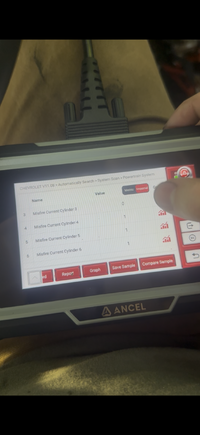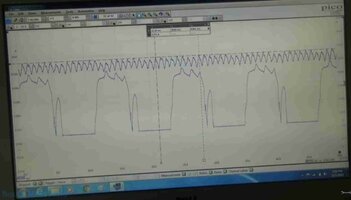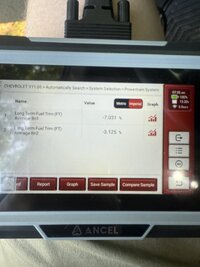AHhh... Now you've touched upon something that can be so obscure as to be missed by the Best of Mechanics when you mentioned...
"Trucks been off the road since November and had to purchase another daily driver, and couldn't get much work done due to a particularly cold New England winter."
Unless you have already considered this as a possibility and gone over the engine nacelle with a Bright Flashlight while wearing M11 Nitrile Gloves, Clear wrap-around Eye Protection and a well fitting N-95 Mask... consider that those conditions may prove to be attracting the North American Deer Mouse (and its ilk) to find hidden nesting and breeding areas under the hood and around the various "cubbies" that these Vermin will use to hide from the winter time cold ...and predators.
As with all rodents, these animals bear ever-growing incisor teeth that require constant gnawing to wear them down. They are particularly enamored of Chewing and Gnawing on Plastic Connectors and Sheathing, Wire Insulation and the Copper beneath it and they will often pull down the Under-Hood Liners for the purposes of creating Nests.
These may be obvious on plain site to include Pine Needles, Animal Fur, Chicken Bones, Feces, Saliva and Desiccated Urine... or they may be found hidden inside of Black Plastic Battery and Fuse Boxes and under Air Ducting, etc. as these images prove:
Images come courtesy @christo829 ...




The latter three mentioned above may carry and harbor the Dreaded Hanta Virus if accidentally inhaled. Though airborne transmission by friable Viral Particle Loaded Dust is rare... if the *Bug* gets into your Eyes, Nose, Throat and Lungs or even cuts and wounds... it Kills 40% of the people who do so and get infected from what is coined by the CDC as HPS (Hanta-Virus Pulmonary Syndrome):

https://duckduckgo.com/?q=cdc+hanta&atb=v445-1&ia=web
Down here in Florida...we also have the Hispid Cotton Rat as the vector of Hanta and what is known as "The Black Creek Canal Disease":

So Please... Be Aware of this situation before You visit their "lair" ...unprepared... and start rustling around the Harnesses, Electrical Module Connectors and roust about any Dried Feces, Saliva and Urine into the air confined under the hood. Use a Wet Cloths soaked in Warm Water and Bleach to wipe down and clean up after these Critters and dispose of the Nesting Trash and Wipes inside of Zip-Lock Baggies. Do not use *Canned Air* or Compressed Air as this will agitate the infected materials and make them Airborne.
PS... A Mouse can Smell and Find a 10 Year Old Dried Out McDonald's French Fry through Three Feet of Cold-Rolled Steel...or the Crack of the Back Seat and Under the Hood, too.
Mechanics should ALWAYS Wash Their Hands of Food Grease and Organic Oils prior to working Under The Hood... else they will wind up coating all of the Wiring and Connectors they Handle with all of those Attractive Smells... and perhaps Doom the Truck Owner to having problems like "Sketchy Starts and Misfires" thereafter once the Mice have managed to Chew It All Up in the offing.
These PDF Articles will also prove very edifying:
"Trucks been off the road since November and had to purchase another daily driver, and couldn't get much work done due to a particularly cold New England winter."
Unless you have already considered this as a possibility and gone over the engine nacelle with a Bright Flashlight while wearing M11 Nitrile Gloves, Clear wrap-around Eye Protection and a well fitting N-95 Mask... consider that those conditions may prove to be attracting the North American Deer Mouse (and its ilk) to find hidden nesting and breeding areas under the hood and around the various "cubbies" that these Vermin will use to hide from the winter time cold ...and predators.
As with all rodents, these animals bear ever-growing incisor teeth that require constant gnawing to wear them down. They are particularly enamored of Chewing and Gnawing on Plastic Connectors and Sheathing, Wire Insulation and the Copper beneath it and they will often pull down the Under-Hood Liners for the purposes of creating Nests.
These may be obvious on plain site to include Pine Needles, Animal Fur, Chicken Bones, Feces, Saliva and Desiccated Urine... or they may be found hidden inside of Black Plastic Battery and Fuse Boxes and under Air Ducting, etc. as these images prove:
Images come courtesy @christo829 ...




The latter three mentioned above may carry and harbor the Dreaded Hanta Virus if accidentally inhaled. Though airborne transmission by friable Viral Particle Loaded Dust is rare... if the *Bug* gets into your Eyes, Nose, Throat and Lungs or even cuts and wounds... it Kills 40% of the people who do so and get infected from what is coined by the CDC as HPS (Hanta-Virus Pulmonary Syndrome):

https://duckduckgo.com/?q=cdc+hanta&atb=v445-1&ia=web
Down here in Florida...we also have the Hispid Cotton Rat as the vector of Hanta and what is known as "The Black Creek Canal Disease":

Gene Hackman's wife died of hantavirus. How common is it in Florida? What to know
Hantavirus comes from contact with rodents — such as rats and mice — especially after exposure to their urine, droppings, and saliva.
www.palmbeachpost.com
So Please... Be Aware of this situation before You visit their "lair" ...unprepared... and start rustling around the Harnesses, Electrical Module Connectors and roust about any Dried Feces, Saliva and Urine into the air confined under the hood. Use a Wet Cloths soaked in Warm Water and Bleach to wipe down and clean up after these Critters and dispose of the Nesting Trash and Wipes inside of Zip-Lock Baggies. Do not use *Canned Air* or Compressed Air as this will agitate the infected materials and make them Airborne.
PS... A Mouse can Smell and Find a 10 Year Old Dried Out McDonald's French Fry through Three Feet of Cold-Rolled Steel...or the Crack of the Back Seat and Under the Hood, too.
Mechanics should ALWAYS Wash Their Hands of Food Grease and Organic Oils prior to working Under The Hood... else they will wind up coating all of the Wiring and Connectors they Handle with all of those Attractive Smells... and perhaps Doom the Truck Owner to having problems like "Sketchy Starts and Misfires" thereafter once the Mice have managed to Chew It All Up in the offing.
These PDF Articles will also prove very edifying:
Attachments
Last edited:









